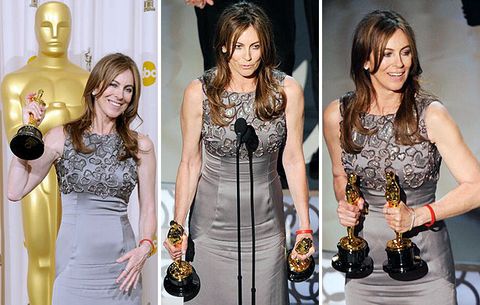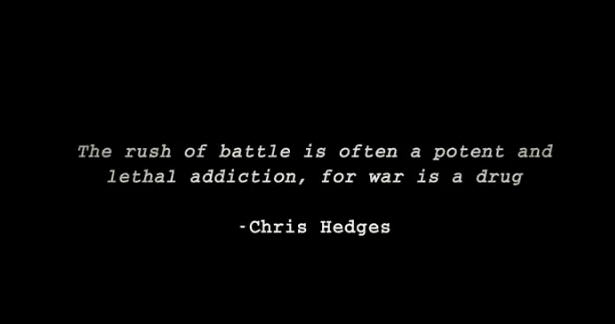
This blog post is highlighting my research area of WOMEN IN FILM. For this blog post, I will be looking into and reflecting on Kathryn Bigelow, the first woman to ever win the Academy Award for Best Director. Personally, I strive to be a great creative in my practice, looking up to women who have succeeded, especially in the male-dominated area of Action films. I will be looking at how she delivers as a director and how she has broken stereotypes of what women do in my practice. This blog post will end with a case study of her Academy Award-winning film, The Hurt Locker (2008).
Possibly the best answer to a question about a woman making a film was by the lead actor in The Hurt Locker (Bigelow, 2008), Jeremy Renner, as he brilliantly states; ‘“What does a set of ovaries have to do with directing a film?”’ (Mayer, 2020). As a woman in the industry this answer makes me smile. Renner encapsulates exactly what should be said about a woman in the film industry, to be treated as an equal filmmaker just like our male counterparts.
At the age of eleven, I remember when the first female had won the Academy Award for Best Director and I was shocked that in the eight-one years before the 2010 Academy Awards there had never been a female winner of the Best Director Award. Before Bigelow’s nomination only three other women had ever been nominated for the Best Director Award. Throughout the time between Bigelow’s nomination for the Awards season (including the Golden Globes) and her win at the Academy Awards, she was in the media more for being in “competition” with her ex-husband, James Cameron, who was nominated for Best Director for his film, Avatar (Cameron, 2009). With some of the press choosing to focus on the topic of their rivalry, instead of the fourth woman to be nominated (and first to then win) the Best Director Oscar, it seems some of the press were more interested in an ex v.s. ex story than the historical female success story. One tabloid chose the title of their article ‘And the Oscar for sweetest revenge on the ex? James Cameron won the divorce… but Kathryn Bigelow got the top prize’ (The Mail Online, 2010) focusing on the rivalry instead of the historic moment that the first ever woman won one of the most prestigious award in the film industry.
For me, being a female has nothing to do with making a film. Most of my favourite directors and screenwriters are men. But this makes me look to why? Are most of my favourite filmmaker’s male because of the lack of representation from their female counterparts? And when a female filmmaker does stand out, do we, as young females, gravitate towards them because of their success looking for a female role model? These have been questions I have been asking myself for years.
As mentioned before in my First Blog post: ‘As a young female screenwriter…’, the genre I gravitate towards – for watching and for writing – is the Action genre. I have always been worried that as a female I would never be able to hold up against my male counterparts in the genre, as I had been told that action films, especially films to do with crime, sci-fi and terrorism is a ‘male’ genre. The person who taught me otherwise was my dad. He told me that anyone can watch anything and therefore can make anything, and that my gender does not define who I can be or what I can do. Along with Renner’s earlier statement, it gives me hope that as a woman in the industry I can strive to do what I want, no matter the genre or role.
Deborah Jermyn argues that the ‘‘Bigelow Look’’ (Jermyn, 2021:370) breaks the stereotype barrier of what a woman filmmaker should be making. Jermyn indicates that some other scholars believe that Bigelow ‘has adopted a mode of ‘muscular filmmaking’… [in order to]… ‘win the respect of a male-dominated industry’’ (Jermyn, 2021:371), implying that in order to survive in the genre as a director she had to become one of the ‘‘hyper-macho bad boy[s]’’ (Jermyn, 2021:371). I believe this to be untrue of Bigelow. Much like Jermyn indicates Bigelow has instead broken those stereotypes and stayed true to herself and her vision of what her action films should be.
For me, Bigelow was one of the Women in Film who inspired me to seek out a career in Film and Television as she is ‘a female pioneer in the male-dominated world of action movies’ (The Guardian, 2010). Over a decade later, Bigelow is helping women, like myself, to push the boundaries and expectations and create action films. The stereotype that only men create these gritty, violent action films was smashed the day Bigelow won that Academy Award. But what if she didn’t? What if in 2010, James Cameron or Quentin Tarantino won the award instead? Would the stereotype still have been broken? In a sense, we as women needed just one person to break the barrier so that we could show the world what we are made of. Just over a decade later, the second woman and first woman of colour, Chloé Zhao won the Academy Award for Best Director for Nomadland (Zhao, 2020).
My LinkedIn post, about women nominations this year, was featured in the LinkedIn Editor’s pick Post. I was one of twelve posts mentioned and I was among writers from The New York Post and Netflix. (Figure 2: Link Below)
https://www.linkedin.com/feed/news/women-directors-break-oscar-drought-5030268

Case Study: The Hurt Locker (Bigelow, 2008) – Character
Bigelow’s film, The Hurt Locker (Bigelow, 2008) won many awards at the Academy Awards including Best Picture and Bigelow’s Best Director Award. I believe that The Hurt Locker’s (Bigelow, 2008) success was down to the writing and directing of the film. For this small case study, I will be delving into the topic of CHARACTER.
Christa van Raatle examines the characters in Bigelow’s films through how they’re presented and how certain themes are shown through them. van Raalte explores the ‘obsessive, single-minded, enigmatic hero’ (van Raalte, 2021:275) that is ever-present in Bigelow’s characters and specifically her protagonists. Sergeant (Sgt.) First Class William James, portrayed by Jeremy Renner, embodies van Raalte’s description. Obsession is the key theme when it comes to Renner’s character. van Raalte examines the idea that Sgt. James ‘is motivated less by cause or country than by his own, perpetual drive’ (van Raalte, 2021:261) which is evident in relation to the theme of obsession through Renner’s character. Sgt. James’ heroic actions in defusing IED’s are overshadowed by James’ reaction. He portrays pleasure and treats the dangerous job as a game, even though it is a life-or-death situation, such shown by the opening death of Thompson. Caetlin Benson-Allott implies the James’ character ‘block[s] access to his emotion’ (Benson-Allott, 2010:43) and therein emphasises the obsession of war. At the beginning of Bigelow’s film, she uses Chris Hughes’ quote ‘“War is a Drug”’ (Benson-Allott, 2010:43). The war correspondent’s quote delves into idea of obsession and addiction, which is exactly what Bigelow presents through her protagonist. Benson-Allott indicates that when James is home from war he is ‘suffering from withdrawal symptoms and ready to return to his addiction’ (Benson-Allott, 2010:43), the addiction being war. James needs war, without it he doesn’t feel whole. He desires the violence, adrenaline, the danger and cannot live without it. Bigelow successfully presents James’ obsession and creates a sense of authenticity, allowing the audience to have a possible insight into the horrors of war, and how some people are drawn to it.

Bibliography:
BAMIGBOYE, B. (2010). And the Oscar for sweetest revenge on the ex? James Cameron won the divorce… but Kathryn Bigelow got the top prize. The Mail Online. [Online]. 9th March. Available from: https://www.dailymail.co.uk/tvshowbiz/article-1256505/James-Cameron-won-divorce–Kathryn-Bigelow-got-Oscars.html [Accessed: 18th October 2021]
JERMYN, D. (2021). How does she look?: Bigelow’s Vision: Visioning Bigelow. New Review of Film and Television Studies. [Online]. 19 (3) pp. 367-382. Available from: https://www-tandfonline-com.ezproxy.herts.ac.uk/doi/pdf/10.1080/17400309.2021.1952036 [Accessed: 18th October 2021]
MAYER, J. (2020). ‘Why Kathryn Bigelow is a trailblazing director’. Videomaker. [Online]. 35 (3). Available from: https://www.videomaker.com/how-to/directing/why-kathryn-bigelow-is-a-trailblazing-director/ [Accessed: 11th October 2021]
VAN RAALTE, C. (2021). ‘The Poetics of Obsession: Understanding Kathryn Bigelow’s characters’. New Review of film and television studies. [Online]. 19 (3). Pp. 256-276. Available from: https://www.tandfonline.com/doi/pdf/10.1080/17400309.2021.1957629 [Accessed: 11th October 2021]
WEAVER, M. (2010). Kathryn Bigelow makes history as first woman to win Best Director Oscar. The Guardian. [Online]. 8th March. Available from: https://www.theguardian.com/film/2010/mar/08/kathryn-bigelow-oscars-best-director Accessed: 7th October 2021]
Filmography:
The Hurt Locker. (2008). Film. Directed by Kathryn Bigelow. [DVD]. US: Summit Entertainment.
Avatar. (2009). Film. Directed by James Cameron. [Blu-Ray]. US: 20th Century Fox.
Illustrations:
Figure 1: Bigelow Academy Awards from Google Images
Figure 2: Link to LinkedIn Editor’s Post
https://www.linkedin.com/feed/news/women-directors-break-oscar-drought-5030268
Figure 3: Hurt Locker still from Google Images
Figure 4: Hurt Locker quote from Google Imageshttps://www.google.com/url?sa=i&url=https%3A%2F%2Fquotesgram.com%2Fdrugs-hurt-quotes%2F&psig=AOvVaw2jpff8SdVMagLovbPqZMJ6&ust=1634647036661000&source=images&cd=vfe&ved=0CAsQjRxqFwoTCLittPr80_MCFQAAAAAdAAAAABAD